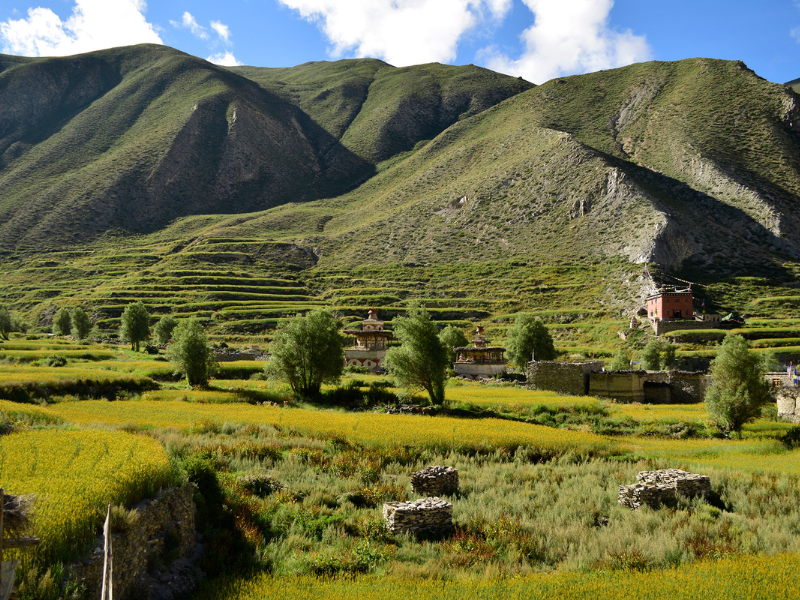Introduction
Of the underrated places in Nepal, the Dolpa district has many natural beauties. The Upper Dolpo Trek is a journey into one of Nepal’s most remote and enigmatic regions, offering an experience like none. There are two main regions in Dolpa: the upper and lower Dolpo. Perched in the shadows of the Himalayas, this trek takes you through barren landscapes, alpine lakes, ancient monasteries, and high-altitude passes. This trek challenges even the most seasoned trekkers. This is one of the most strenuous treks in Nepal, with elevations over 5000 meters. It opened just a few years back for trekkers, and this is one of the least-traveled regions in Nepal.
Although the trek is pretty challenging, the beautiful landscape will still amaze trekkers. During the trek, you can witness heavy Tibetan influence on the region. During the trek, you can explore famous monasteries like the Shey Gompa, an old monastery where centuries-old Buddhist and Bonpo traditions are still practiced. This article features some overviews of the trekking in the Dolpo region and some practical information.
Some Information On The Upper Dolpo Trek:
- Maximum Elevation: 4500 meters
- Trek’s Destination: Shey Gompa, Upper Dolpo
- Trek Duration: 19 days
- Difficulty: Challenging
Highlights Of the Upper Dolpo Trek:
- Shey-Phoksundo Lake: One of the most popular lakes of Nepal, Shey Phoksundo is a pristine freshwater lake. Located at an elevation of 3611 meters above sea level, this lake is one of the most picturesque lakes in Nepal. Scared to the locals, this is one of the most beautiful lakes in Nepal. Surrounded by snow-capped peaks and high hills, it is one of this trek’s serene and picturesque highlights. The bluish water of this lake is a refreshing sight for trekkers after an exhausting trek.
- Shey Gompa: It is a 12th-century monastery at the base of a mountain. Shey Gompa is a spiritual and cultural hub in the Upper Dolpo region. This monastery is a major pilgrimage site for Tibetan Buddhists and Bon. From the monastery, you can get panoramic views of the entire region. The monastery has a two-story building colored red, and the interior has various Buddhist paintings.
- Tibetan-inspired Culture: The region’s inhabitants, the Dolpo-pa, have preserved their tradition and culture for centuries. You’ll encounter old monasteries, prayer flags, chortens, and unique culture, and it feels like you’re in a different era. You can also enjoy Tibetan-influenced foods during the trek.
- High Mountain Passes: This trek involves crossing challenging high-altitude passes like Kang La and Saldang La. It offers breathtaking panoramic views of the Himalayas ranges and rugged terrain.
- Rare Wildlife: The Upper Dolpo trek takes you through the Shey Phoksundo National Park, which is home to rare species like the snow leopard, Blue Sheep, and musk deer. The untouched wilderness of this region will give you plenty of opportunities to spot a rare wild animal.
Route Overview
Kathmandu-Shey Phoksundo Lake (6 Days)
The first half of the trek requires us to travel from Kathmandu to the Shey Phoksundo Lake. On the first day, you will fly from Kathmandu to Nepalgunj. On the first day, you can explore Nepalgunj and stay overnight there. You will take a morning flight from Kathmandu to Juphal on the second day. Once you land, your trekking begins, and you must reach Sulighat by evening. The trail from Juphal to Sulighat is quite comfortable and easy. On the third day, you must aim to reach Chepka. You will pass Aanke Khola, ascend alongside the Suli River, and reach your third day’s destination. On the fourth day, you must trek to Samduwa. This part of the trek is one of the most challenging as you will quickly ascend. On the fifth day, you shall reach Ringmo Gaon and eventually the Shey Phoksundo Lake. Acclimatization is also necessary.
Shey Phoksundo Lake- Saldang La (6 Days)
Although this part of the trek is pretty challenging, you will find it very picturesque, too. You will cross high-altitude passes and witness breathtaking scenery during this part of the trek. The resources get more scarce, and the trails are more challenging in this part of Dolpa. There are very few tea houses here, so you might also have to tent somewhere along the way. As Shey Gompa is one of the highlights of the trek, you can acclimatize there. There are numerous villages and monasteries which you can explore. Shey Gompa is part of the Chaiba community, which includes Padmasambhava. As you will pass several high-altitude passes, this part of the trek is pretty challenging.

Saldang La- Juphal (7 Days)
After leaving Saldang village, you will descend towards Sibu. You must stay overnight at a tented camp in Sibu. You will cross several villages like Tokyu Gaon, Dho Tarap, Jeng La Phedi, and many more. After trekking for a few days, you will notice the change in elevation. As you descend, the resources are easily available, and you’ll see more civilization along the way. Following the Bheri River, you will reach Juphal in seven days.
Practical Informations
- You must acquire all necessary permits before you head out for this trek. As this trek was only opened a few years back, very few have been to this region.
- As this is a very long trek, you must be well-prepared. You should also carry tents, enough food and water supplies, and safety kits.
- Proper acclimatization is needed, as you may suffer from altitude sickness.
- Traveling with a group might be helpful in less-traveled locations.
Also Read: How Far Should You Hike In A Day: Top Day Hikes In Kathmandu


0 Comment